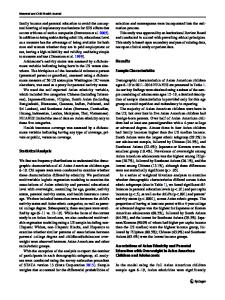Dysglycaemia and South Asian ethnicity: a proteomic discovery and confirmation analysis highlights differences in ZAG
- PDF / 533,015 Bytes
- 10 Pages / 595.276 x 790.866 pts Page_size
- 81 Downloads / 298 Views
ORIGINAL ARTICLE
Dysglycaemia and South Asian ethnicity: a proteomic discovery and confirmation analysis highlights differences in ZAG Harriet M. Pearsey1,2,3 · Joseph Henson1,2 · Jack A. Sargeant1,2 · David Webb1,2 · Jason M. R. Gill4 · Carlos Celis‑Morales4 · Toru Suzuki2,5 · Helen Waller1 · Kamlesh Khunti1,6 · Leong L. Ng2,5 · Kelly A. Bowden‑Davies7 · Daniel J. Cuthbertson8 · Andrew Jackson9 · Melanie J. Davies1,2 · Thomas Yates1,2 Received: 29 June 2020 / Revised: 2 September 2020 / Accepted: 12 September 2020 © The Author(s) 2020
Abstract Aims To (1) explore and verify differences in the plasma proteome of white European (WE) and South Asian (SA) adults with normal glycaemic control (NGC) or non-diabetic hyperglycaemia (NDH) and to (2) validate these findings using a separate WE and SA cohort at a high risk of NDH. Methods Mass spectrometry analysis was performed on fasted samples from 72 WE or SA men with NGC or NDH. These results were verified using specific biochemical assays and validated by repeating the analysis in an additional cohort of 30 WE and 30 SA adults. Proteomic results were analysed using independent samples t test and univariate analysis. The targeted assay results were analysed using generalised linear models with adjustment for appropriate covariates including age, BMI, fasting plasma glucose, high-density lipoprotein-cholesterol, triglycerides and sex. Results Only zinc-alpha-2-glycoprotein (ZAG) significantly differed between both ethnicities and glycaemic control groups. ZAG-specific biochemical assays verified the lower circulating ZAG in SAs (41.09 versus 37.07 (mg L−1); p = 0.014), but not the difference between NGC and NDH groups (p = 0.539). Validation of the ethnicity difference in a separate cohort confirmed that, after adjustment for covariates, ZAG was lower in SAs (p = 0.018). There was no association between ZAG and glycaemic control in the validation cohort. Conclusions Our analyses identified that ZAG is lower in SAs compared to WEs, but its difference between glycaemic control statuses was uncertain. Further research is needed to establish whether lower ZAG in SAs is associated with, or prognostic of, health outcomes, particularly regarding the risk of dysglycaemia. Keywords Proteomics · Mass spectrometry · Enzyme-linked immunosorbent assay · AZGP1 · Dysglycaemia · Type 2 diabetes mellitus
Electronic supplementary material The online version of this article (https://doi.org/10.1007/s42485-020-00046-7) contains supplementary material, which is available to authorized users. * Harriet M. Pearsey [email protected] 1
Leicester Diabetes Centre, Leicester General Hospital, University of Leicester, Gwendolen Road, Leicester LE5 4PW, UK
2
NIHR Leicester Biomedical Research Centre, Leicester Glenfield General Hospital, Groby Road, Leicester, UK
3
Department of Health Sciences, University of Leicester, Leicester, UK
4
Institute of Cardiovascular and Medical Sciences, University of Glasgow, Glasgow, UK
5
Cardiovascular Sciences Department, Un
Data Loading...











